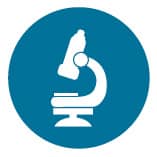
“You don’t have to have everything planned out in high school.”
Beetlemania
Dr. Eusondia Arnett’s Story

For some people, their career path seems clear, leading them smoothly from point A to point B. However, for Dr. Eusondia Arnett, staff scientists and Lab Director at Texas Biomedical Research Institute, the path to her career did not come with a GPS. In high school, Eusondia was curious about how a complex system, like the human body, could be made up of individual cells. She decided her path to a science career meant becoming a medical doctor. Eusondia studied microbiology at Wright State University in Ohio where she met professors who introduced her to science research. She realized there were other career pathways besides being a medical doctor. With her professors’ guidance, she decided to change directions to pursue a career in science research. Her science career destination changed from MD to PhD.
Getting into graduate school meant fierce competition for a limited number of positions. To improve her chances, she needed more research experience. Through her network of friends, mentors, and colleagues, Eusondia found a research position with the US Department of Agriculture (USDA), trapping and counting Japanese and Emerald Ash Borer beetles, invasive species that damage crops. At the same time, she joined a research lab at Wright State University studying plant responses to Emerald Ash Borer beetles. Her work with beetles provided the research experience she needed to be competitive for graduate school. She attended graduate school at Ohio State University, where she earned her PhD in microbiology. There she expanded her network of colleagues and mentors. Having earned her PhD, Dr. Arnett’s path led her to a post-doctoral fellow at Ohio State University Wexner Medical Center. One of her mentors, Dr. Schlesinger, was impressed with her work. When he accepted a position at Texas Biomedical Research Institute and asked Eusondia if she would like to continue her research in San Antonio. She accepted the opportunity and headed to Texas!
Dr. Arnett is the Lab Director for Dr. Schlesinger, who conducts tuberculosis research in Biosafety Lab Level 2 (BSL2) and BSL3 labs. In a BSL2 and BSL3 lab, scientists study infectious diseases that are curable and treatable. Dr. Arnett may have started her professional career following beetles, but her drive, curiosity, and willingness to follow different paths led her to a career where she finds treatments and cures for infectious diseases. She would not be where she is today without her curiosity, determination, and her network of colleagues and mentors. In hindsight, Eusondia wished she had known in high school that there were other pathways in science besides being a medical doctor. She offers this advice to students: “You don’t have to have everything planned out in high school.” There are many pathways and areas that branch from biomedical research.
Additional Materials
Discussion Questions
- Dr. Arnett has a network of colleagues and mentors. Describe the role of a mentor. If you have a mentor, how do they contribute to your life?
- What is your main “take-away” for you from Dr. Arnett’s story? Explain why.
Suggested Activity
- Develop poster/presentation about:
- Tuberculosis research (Possible Content: the cause, symptoms, treatments, TB testing, local research)
- Microbiology Careers (Possible Content: define, identify and describe careers, describe ways in which this science impacts lives)
- Immunology Careers (Possible Content: define, identify and describe careers, describe ways in which these sciences impact lives)